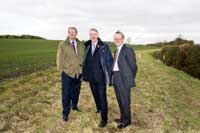CFE: Campaign begins in earnest

Industry leaders will step up their efforts to persuade farmers to join their Campaign for the Farmed Environment this winter and stave off the threat of a compulsory set-aside replacement across England.
Farm leaders are warning that the campaign is the only way of retaining the environmental benefits of set-aside without extra regulations and costs being imposed on farmers. But thousands of producers remain unconvinced about its merits.
Some 46% of farmers are reluctant to implement voluntary environmental measures on their farms, according to a straw poll which has attracted more than 400 responses on FWi over the past week.
But the government has warned that compulsory regulations will be introduced unless farmers use environmental stewardship, fallow land and other measures to boost farmland birds, wildlife and protect resources like soil and water.
Opposition
Although unscientific, the poll is the first indication of farmers’ attitudes to the campaign since its launch on Thursday, 5 November. And their comments suggest there is a mountain to climb to make the initiative a success.
Producers already in Entry Level Stewardship (ELS) will be asked to choose at least one in-field option when they renew agreements – as more than 30,000 are expected to do next year. Farmers not in ELS will be urged to join as soon as possible.
All farmers will be asked to retain their current area of uncropped land and adopt at least one additional voluntary measure to meet the campaign targets. Farm advisers are being trained to help producers select the best options.
NFU president Peter Kendall hosted the launch event with industry stakeholders, government representatives and conservationists on his family farm at Eyeworth, Bedfordshire. It was vital that the campaign succeeded, he told listeners.
Higher crop yields over the past 30 years, had resulted in unintended consequences, said Mr Kendall. “As we meet the challenges of producing more, we must make sure we impact less on the environment, and that we do so in a smarter way.”
Farmers had already made real progress, Mr Kendall said. Some two-thirds of the countryside – equivalent to 58,000 agreements covering 6m hectares – was now farmed under environmental stewardship agreements.
Targets
But the campaign’s targets are even more ambitious. Key in-field ELS options must be doubled to 40,000ha within three years. The current 179,000ha of uncropped land must be retained and voluntary environmental management increased by 30,000ha.
Collectively for the industry, the campaign was a major ask. But given the right encouragement and the right support, small actions by individual farmers would ensure that it succeeded.
The campaign unites key agricultural stakeholders – including ancillary industry representatives and farm conservation groups – to work in partnership with DEFRA, Natural England, the Environment Agency and the RSPB.
DEFRA secretary Hilary Benn said he believed voluntary measures has potential to deliver a better outcome than regulation. Tapping into farmers’ enthusiasm was preferable to forcing reluctant producers into action, he suggested.
Profitable farming and looking after the environment were not mutually exclusive. “The industry and all the partners have taken on a very big responsibility. It is a big task. But I am absolutely confident that we are going to succeed.”
Henry Aubrey-Fletcher, who has since been succeeded as president of the Country Land and Business Association, said the campaign was the boldest initiative he had seen in more than 40 years of farming.
“I urge every farmer, landowner and land manager to adopt at least one of the campaign’s voluntary measures on your land,” he said. “There is something for everyone in the campaign.”
